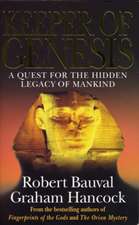Droughts, Food and Culture: Ecological Change and Food Security in Africa’s Later Prehistory
Editat de Fekri A. Hassanen Limba Engleză Hardback – 31 mar 2002
Global climatic changes become manifest initially in regions that are marginal or unstable. Africa's Sahel zone is one of the most sensitive climatic regions in the world and the events that have gripped that region beginning in the 1970's were the first indicator of a significant shift in global climatic conditions.
This work aims to bring archaeology with the domain on contemporary human affairs and to forge a new methodology for coping with environmental problems from an archaeological perspective. Using the later prehistory of Africa as a comparison, the utility of this methodological strategy in interpreting culture change and assessing long-term response to current, global climatic fluctuations is examined and understood.
| Toate formatele și edițiile | Preț | Express |
|---|---|---|
| Paperback (1) | 643.84 lei 6-8 săpt. | |
| Springer Us – 17 sep 2011 | 643.84 lei 6-8 săpt. | |
| Hardback (1) | 652.49 lei 6-8 săpt. | |
| Springer Us – 31 mar 2002 | 652.49 lei 6-8 săpt. |
Preț: 652.49 lei
Preț vechi: 767.63 lei
-15% Nou
Puncte Express: 979
Preț estimativ în valută:
124.85€ • 130.10$ • 103.38£
124.85€ • 130.10$ • 103.38£
Carte tipărită la comandă
Livrare economică 03-17 aprilie
Preluare comenzi: 021 569.72.76
Specificații
ISBN-13: 9780306467554
ISBN-10: 0306467550
Pagini: 347
Ilustrații: XIX, 347 p. 52 illus.
Dimensiuni: 155 x 235 x 29 mm
Greutate: 0.75 kg
Ediția:2002
Editura: Springer Us
Colecția Springer
Locul publicării:New York, NY, United States
ISBN-10: 0306467550
Pagini: 347
Ilustrații: XIX, 347 p. 52 illus.
Dimensiuni: 155 x 235 x 29 mm
Greutate: 0.75 kg
Ediția:2002
Editura: Springer Us
Colecția Springer
Locul publicării:New York, NY, United States
Public țintă
ResearchCuprins
Palaeoclimate, Food and Culture Change in Africa: An Overview.- Climatic Change.- Rapid Holocene Climate Changes in the Eastern Mediterranean.- Climate During the Late Holocene in the Sahara and the Sahel: Evolution and Consequences on Human Settlement.- Late Pleistocene and Holocene Climatic Changes in the Central Sahara. The Case Study of the Southwestern Fezzan, Libya.- Late Holocene Climatic Fluctuations and Historical Records of Famine in Ethiopia.- Environmental and Human Responses to Climatic Events in West and West Central Africa During the Late Holocene.- Plant Cultivation.- Regional Pathways to Agriculture in Northeast Africa.- From Hunters and Gatherers to Food Producers: New Archaeological and Archaeobotanical Evidence from the West African Sahel.- Holocene Climatic Changes in the Eastern Mediterranean and the Spread of Food Production from Southwest Asia to Egypt.- Sustainable Agriculture in a Harsh Environment: An Ethiopian Perspective.- Pastoralism.- The Evidence for the Earliest Livestock in North Africa: or Adventures with Large Bovids, Ovicaprids, Dogs and Pigs.- Cultural Responses to Climatic Changes in North Africa: Beginning and Spread of Pastoralism in the Sahara.- Dry Climatic Events and Cultural Trajectories: Adjusting Middle Holocene Pastoral Economy of the Libyan Sahara.- Food Security in Western and Central Africa During The Late Holocene: The Role of Domestic Stock Keeping, Hunting and Fishing.- Bovines in Egyptian Predynastic and Early Dynastic Iconography.- Conclusion.- Conclusion: Ecological Changes and Food Security in the Later Prehistory of North Africa: Looking Forward.
Recenzii
From the reviews:
"This is a must reading for serious students of African prehistory as it merges into history."
(Choice, 40:4 (2002)
"The Volume's geographically based organization is advantageous. It allows the reader to pinpoint the research themes dominating the various regions. Thus, mobility strategies, population dynamics, and political upheavals account for changing land use due to desertification across Southwest and Central Asia. This book succeeds in demonstrating the range of methodological and heuristic templates currently applied to human ecological modeling in marginal environments. A corollary and sobering observation, independently noted in each study area, is that archaeology confirms and often accurately gauges historic trends."
(Journal of Anthropological Research, 59 (2003)
"This book is an important pioneering study that brings together in 17 chapters the evidence for changes in climate that occurred in Africa during the last 10,000 years or so, and the observed human responses to those changes. It is an attractive book, well-designed with numerous clear and informative illustrations. ...all archaeologists should read the first two chapters by Hassan, who sets the stage for and summarizes the most important data in the book. ...should be read not only by those interested in problems of climate change in Africa and elsewhere, but by anyone interested in the interaction between human behavior and climate change. We urge Hassan to call another conference on Holocene climate variability and human response in North Africa. He should also produce another book, because more detailed summaries like many of these in this volume will rapidly move us toward his goal "to situate archaeologuy within the domain of contemporary human affairs"."
(African Archaeological Review, 20:2 (2003)
"Implications with contemporary climate events (recurrent droughts in Africa) and their impacts on food securityare evident. Interactions amongst climate changes, evolution of food producing systems, evolution of societal organization including mass movements in search of less hostile environment, evolution of culture, art and technology, are all intertwined and complicated. The chapters of this remarkable volume dispel a good deal of the myth that relates to these socio-evolutionary topics."
(The Environmentalist, 23 (2003)
"The substantive papers of this volume remain data-grounded but theoretically informed, and bring together new information on archaeology and the interlocking of subsistence activities with their environmental context." (Karl W. Butzer, Holocene, 14, 2004)
"At the very least, all archaeologists should read the first two chapters by Hassan, who sets the stage for and summarizes the most important data in the book. It is also a book that should be read not only by those interested in problems of climate change in Africa and elsewhere, but by anyone interested in the interaction between human behavior and climate change." (Fred Wendorf and Romuald Schild; African Archaeological Review, 20:2)
"The book, edited by F. Hassan, is an excellent and accomplished attempt to summarise the archaeology of North Africa as the historical relationship between the people and climatic change during the Holocene. This is also a book with wider implications. … This is a book I warmly welcomed and read with interest, as it is full of new data and ideas." (Marco Madella, Geoarchaeology, March, 2005)
"This is a must reading for serious students of African prehistory as it merges into history."
(Choice, 40:4 (2002)
"The Volume's geographically based organization is advantageous. It allows the reader to pinpoint the research themes dominating the various regions. Thus, mobility strategies, population dynamics, and political upheavals account for changing land use due to desertification across Southwest and Central Asia. This book succeeds in demonstrating the range of methodological and heuristic templates currently applied to human ecological modeling in marginal environments. A corollary and sobering observation, independently noted in each study area, is that archaeology confirms and often accurately gauges historic trends."
(Journal of Anthropological Research, 59 (2003)
"This book is an important pioneering study that brings together in 17 chapters the evidence for changes in climate that occurred in Africa during the last 10,000 years or so, and the observed human responses to those changes. It is an attractive book, well-designed with numerous clear and informative illustrations. ...all archaeologists should read the first two chapters by Hassan, who sets the stage for and summarizes the most important data in the book. ...should be read not only by those interested in problems of climate change in Africa and elsewhere, but by anyone interested in the interaction between human behavior and climate change. We urge Hassan to call another conference on Holocene climate variability and human response in North Africa. He should also produce another book, because more detailed summaries like many of these in this volume will rapidly move us toward his goal "to situate archaeologuy within the domain of contemporary human affairs"."
(African Archaeological Review, 20:2 (2003)
"Implications with contemporary climate events (recurrent droughts in Africa) and their impacts on food securityare evident. Interactions amongst climate changes, evolution of food producing systems, evolution of societal organization including mass movements in search of less hostile environment, evolution of culture, art and technology, are all intertwined and complicated. The chapters of this remarkable volume dispel a good deal of the myth that relates to these socio-evolutionary topics."
(The Environmentalist, 23 (2003)
"The substantive papers of this volume remain data-grounded but theoretically informed, and bring together new information on archaeology and the interlocking of subsistence activities with their environmental context." (Karl W. Butzer, Holocene, 14, 2004)
"At the very least, all archaeologists should read the first two chapters by Hassan, who sets the stage for and summarizes the most important data in the book. It is also a book that should be read not only by those interested in problems of climate change in Africa and elsewhere, but by anyone interested in the interaction between human behavior and climate change." (Fred Wendorf and Romuald Schild; African Archaeological Review, 20:2)
"The book, edited by F. Hassan, is an excellent and accomplished attempt to summarise the archaeology of North Africa as the historical relationship between the people and climatic change during the Holocene. This is also a book with wider implications. … This is a book I warmly welcomed and read with interest, as it is full of new data and ideas." (Marco Madella, Geoarchaeology, March, 2005)
Caracteristici
Situates archaeology within the domain of contemporary human affairs Highlights the aspects of historical relationships between people and climatic change Interprets contemporary climatic events and their consequences with the knowledge of long-term climatic variability












